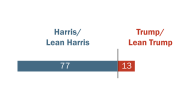56% of all Americans have accessed the internet by wireless means.
An April 2009 survey conducted by the Pew Research Center’s Internet & American Life Project asked respondents whether they had used a variety of devices – laptops, cell phones, game consoles, and more – to go online using a wireless network. Altogether, 56% of Americans said they have at some point used wireless means for online access.
- 39% of all Americans have used a laptop computer to go online wirelessly, making this the most prevalent means of wireless access.
- 32% of all Americans have gotten online with a mobile device – meaning they have used a cell phone or other handheld device to check email, access the internet for information, or send instant messages.
Together, laptop and mobile wireless access account for the vast majority of wireless access, as 51% of Americans have gotten online using either of these two methods. Some people (19% of Americans) opt for both means of wireless access – portable laptops on fast WiFi networks or handheld access on slower networks from cell carriers.
Use of the internet on mobile devices has grown sharply from the end of 2007 to the beginning of 2009.
- In December 2007, 24% of Americans said they had at some point used the internet on their mobile device.
- By April 2009, 32% of Americans said they had at some point used the internet on their mobile device.
- In December 2007, 11% of Americans said they had yesterday accessed the internet on their mobile.
- By April 2009, 19% of Americans said they had yesterday accessed the internet on their mobile.
African Americans are the most active users of the mobile internet – and their use of it is also growing the fastest. This means the digital divide between African Americans and white Americans diminishes when mobile use is taken into account.
- 48% of Africans Americans have at one time used their mobile device to access the internet for information, emailing, or instant-messaging, half again the national average of 32%.
- 29% of African Americans use the internet on their handheld on an average day, also about half again the national average of 19%.
- Compared with 2007, when 12% of African Americans used the internet on their mobile on the average day, use of the mobile internet is up by 141%.
The high level of activity among African Americans on mobile devices helps offset lower levels of access tools that have been traditional onramps to the internet, namely desktop computers, laptops, and home broadband connections.
- By a 59% to 45% margin, white Americans are more likely to go online using a computer on a typical day than African Americans.
- When mobile devices are included in the mix, the gap is cut in half; 61% of whites go online on the average day when mobile access is included while 54% of African Americans do.
- Looking across a range of digital activities – some done online typically using a computer and others being non-voice data activities on a mobile device – African American and white Americans, on average, do the same number of activities.
Broader measures of use of mobile digital resources also show fast growth from the end of 2007 to the beginning of 2009.
In 2007 and 2009, respondents were asked about ten different non-voice data activities they might do on their cell phones: sending or receiving text messages, taking a picture, playing a game, checking email, accessing the internet, recording video, instant messaging, playing music, getting maps or directions, or watching video. Although several activities involve using the internet on the mobile device, many (such as taking a picture) do not.
- In 2009, 69% of all adult Americans said they had ever done at least one of the ten activities versus 58% who did this in late 2007.
- In 2009, 44% of all adult Americans said they had done at least one of the non-voice data activities on the typical day, up from 32% in 2007.
Other access devices – iPods, game consoles, or e-books – for now play a small role in people’s wireless online habits.
- 45% of adults have iPods or MP3 players, but only 5% of adults have used such a device to go online.
- 41% of adults have game consoles and 9% of adults have used it to go online.
- 14% of adults say they have a personal digital assistant and 7% of adults have used a PDA to go online.
- 2% of adults say they own an e-book reader – a Kindle or a Sony reader – and just 1% of all adults have used it to access the internet.
This comes to 17% of Americans who have used one these four devices for wireless internet access, but the pool of users on these devices adds just 5 percentage points to the pool of wireless users. In other words, absent users of these devices for wireless access, 51% of Americans would be wireless internet users, not 56%.
When mobile users are away from home or the office, they like mobile access to stay in touch with others, but also to access information on the go.
When mobile users were asked to think about how they get information or communicate with others while away from home or work:
- 50% say it is very important to them to have mobile access in order to stay in touch with other people.
- 46% say they mobile access is very important for getting online information on the go.
- 17% say mobile access is very important to them so they can share or post online content while away from home or work.
The April 2009 survey interviewed 2,253 adult Americans, including 561 who were interviewed on their cell. The margin of error in the survey is plus or minus two percentage points for results based on the entire sample. The survey contained 1,687 internet users and the margin of error for results based on internet users is plus or minus 3 percentage points. The survey contained 1,818 respondents who are cell phone users, and the margin of error for results based on questions directed at cell phone users is plus or minus 2.5 percentage points. The data points above for December 2007, used in comparisons with the April 2009 survey, come from a survey with cell phone numbers included in the sample.




